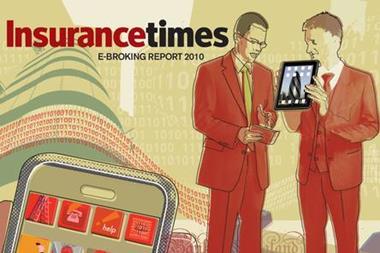About half of the UK’s insurance business now passes through one of 100 aggregator portals. But while it may suit customers in search of ever-lower premiums, many brokers are concerned about long-term damage to the industry
Along with giving us the most annoying/wonderfully funny (delete to taste) television advertisements, aggregators have revolutionised the insurance industry with their pile it high and sell it cheap philosophy.
But brokers are still wary of the aggregator model as a vehicle for driving business. On the one hand, aggregators have transformed the fortunes of a number of brokers whose volumes have soared on the back of comparison websites. They have also provided insurance companies with the opportunity to sell their wares direct to millions of customers.
But they stand accused of dragging prices lower, damaging the overall profitability of the market. Meanwhile, some brokers fear they will be driven out of business as more consumers choose to buy direct – a threat that is likely to intensify as aggregators extend their reach into other lines, particularly commercial.
Ten years ago, there were fewer than half a dozen financial services aggregators in the UK. Today there are about 100. But only four are of any scale: Gocompare, Moneysupermarket, Confused.com and Comparethemarket. Between them, the big four spend about £280m a year on advertising to ensure they stay on top of an increasingly competitive market.
Moneysupermarket insure, home services and travel division managing director, Graham Donoghue, says the four spent about £84m on above-the-line television advertising last year. Moneysupermarket, for example, spent north of £15m on its TV campaign featuring comedian Omid Djalili promoting the art of haggling.
Is this kind of spend sustainable? Gocompare founder and chief executive, Hayley Parsons – employer of the best-known tenor since Pavarotti – thinks it is. “Yes, there is a lot of money going into advertising, but for us it’s working really well,” she says.
With an estimated 50% of the UK’s insurance business now passing through their collective portals, including up to 70% of private motor insurance, Parsons has a point. But as the advertising spend shows, you need deep pockets to get a foothold in the market and that means there’s little prospect of fresh competition.
“It’s easy to start a site but hard to make it successful,” Donoghue says. “You need a minimum of £30m to start a site of scale, so cash is a big barrier to entry these days.”
Parsons agrees. “Our original plans when launching Gocompare were relatively small. But when we heard that Tesco Compare was coming into the market, we decided to go for a big launch. I took out a loan facility for £30m with the intention of becoming one of the top three. We made it [into the top three] and Tesco didn’t. But that’s the kind of cash you need to launch now,” she says.
Despite the number of players, Donoghue and Parsons dismiss talk of consolidation. “What they can deliver versus what we already deliver means there is no value in them for us,” Parsons says.
Brokers’ relationship with aggregators has gone from an initial scepticism to co-operation, but is now approaching something akin to suspicion and downright annoyance.
At a time when insurers are suffering declines in premium income, coupled with a sharp increase in claims and lower profits, many are concerned that the premium-led nature of aggregators is damaging the industry.
“By its very nature, it’s a competitive, premium-driven model that effectively forces prices down,” This Insurance product development manager, John Mason, says. “Insurers are chasing to be top of the list when the customer hits the quote button.” (This Insurance, the commercial underwriting business of JLT’s Thistle Insurance, does not work with aggregators.)
But in some respects, consumers can be the worst culprits in driving prices down. AXA’s director of personal lines (intermediary), Mike Keating, says it is becoming apparent that business derived from aggregators performs less well than that from traditional routes, partly because it is easy for users to manipulate online question sets.
“People input information they believe will get them the cheapest quote … we have to look at how that can be effectively policed. The classic is mileage; everyone seems to do 6,000 miles a year and, of course, every car is garaged. We can do Q-checking and while, at present, it’s post-claim, it does mean that if people aren’t honest when supplying their details, their claim can become invalid,” he says.
Brokers continue to watch nervously as the aggregators’ grip becomes tighter. Macbeth is a small London broker, and its sales director Tony Gibb says the continuing advance and use of technology, with the aggressive marketing of aggregators, is squeezing brokers out of some lines.
Donoghue concedes that some brokers are suffering. “But if you take our top 10 clients in terms of volume, about 40% are still through brokers. If we can acquire customers cost-effectively and pass them through to brokers, then that’s a model that works for everyone. Where brokers have a strategy for working with aggregators, it tends to work quite well.”
Parsons agrees. “On car insurance, we have 120 partners. A large percentage of those are brokers and they pick up around half the business. If you look at online car and home insurance, brokers have benefited much more than direct insurers in terms of volume that they never would have achieved before.”
Because large segments of the personal lines market are still not fully covered by aggregators, both Donoghue and Parsons see the future of comparison sites remaining firmly fixed on private insurance. “Car insurance is more mature, of course, but home insurance is a couple of years behind that,” Donoghue says. “Travel insurance offers scope, there’s only around four million policies sold through comparison sites out of a market of about 20 million, and life insurance is growing incredibly fast.”
Although aggregators have moved into commercial, they are surprisingly less sanguine about the prospects of a wholesale shift of the market to the internet in the near future.
“I’d be really keen to see it take off and work but I think we’re many years away from it,” Parsons says. “Before comparison sites can look at it, insurers and brokers have to get their act together with regard to online quotability. Until there is a solid online quoting foundation across insurance and brokers, I don’t think commercial insurance is something that aggregators can do a lot on. It will get there, but it’s a long way off.”
Donoghue adds: “We all do commercial, but it’s quite crude and tends to be more of an advertising listing vehicle than a true comparison, which is partly due to the technology. Expanding it isn’t specifically on our radar.”
But Henderson’s group broking director, Gordon Brain, believes large chunks of the commercial market will eventually fall prey to aggregators, although he insists they’re unlikely to replicate the dominance enjoyed in personal lines. “There are concerns, but in reality it’s only small SME and packaged business that lends itself to online. In terms of complex risk or corporate, aggregators are a long way off.”
Brokers: breathe a sigh of relief. IT
Hosted by comedian and actor Tom Allen, 34 Gold, 23 Silver and 22 Bronze awards were handed out across an amazing 34 categories recognising brilliance and innovation right across the breadth of UK general insurance.














































No comments yet